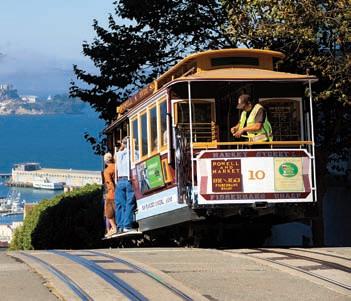
30 minute read
Colorado’s Rock-Solid Boulder
ODYSSEY
THE MAGAZINE OF THE CHEVRON AUTO CLUB
Advertisement

Dear Members, Many folks find the cooler temperatures and less crowded roads and destinations of fall and winter the ideal time to hit the road and travel. Whether seeking the beauty of a national park, the relaxation of a resort, or the pleasure of visiting family or friends—for the holidays or any other occasion—you might be one of our nation’s winter wayfarers. But ODYSSEY content isn’t just for the benefit of one-season travelers. ODYSSEY is really about travel all year round. You might want to make one of our featured destinations the end point of a trip, or a way point along your way, but there is more. Chevron Auto Club offerings are a source of comfort and security to travelers, and the Bulletin page is filled with items of interest to all, especially those on the go.
In this issue we will take you to Boulder, Colorado—a city with a mining history, outdoor recreation opportunities aplenty, and arts, culture, and sports performances presented thanks to a major university and one of the permanent Chautauqua centers in the U.S. And we’ll take a peek at the local practice of rock balancing. What is rock balancing you ask? Pretty amazing would be our response.
And we will investigate the Springfield phenomenon—taking a look at the fact that there are a lot of Springfields scattered all across many of the forty-eight states, yes, forty-eight. It turns out there are a lot of Springfields, but no Springfields in Alaska or Hawaii.
Are you ready to get out of your routine for something different? How about a cruise? You might be surprised—pleasantly so—at the changes that have been made by cruise lines to make cruising safer and just as comfy as ever. Staying close to home, you will find offerings that take you to a variety of ready-to-explore destinations off our very own shores. Or you can just stay on board and relax with the creative assortment of dining, recreational, and entertainment offerings on hand.
Finally we’ll focus our editorial lens on Holland—or, more correctly, the Netherlands. It turns out that Holland, although commonly used as the country’s name, is really just part of this compact country of canals, history, and—bikes! Wishing you, as always, safe travels,

Patrick JO’Brien, President, Chevron Auto Club


Your Auto Club IsAlways As Near As The Phone! For Auto Club Information contact:
Chevron Auto Club, P.O. Box 830008, Miami, FL 33283-0008 Call toll-free, Monday through Friday 7:00 a.m. to 7:00 p.m. Central time 1-800-677-3939
Questions and comments regarding this magazine may be addressed directly to: Editor, ODYSSEY, 131Stony Circle,SantaRosa,CA95401; cadb-delta@sonic.net
Visit the Chevron Auto Club online at: www.ChevronAutoClub.com

Volume 53 Number 1 Winter 2022
On the cover: The well-used Royal Arch Trail in Chautauqua Park takes hikers to the natural arch—a popular destination near Boulder.
Photo: Adam Hodges/Shutterstock
ODYSSEY
President Chevron Auto Club Patrick JO’Brien
ODYSSEY
is created, edited, and designed by the editorial staff and associates
of CABergquist&Associates
Advertising Representative National
CABergquist&Associates 916/668-9530
Contents


02 Colorado’s Rock-Solid Boulder
Not far from Denver, but distant in many respects, Boulder is a place tied to nature by virtue of its setting at the foot of the Rocky Mountains’ Front Range. There is plenty to do in town, but the mountains to the west draw many seeking recreation, scenic views, history, and nature. by Allen Denson
08 Cruising—Keeping Up with the Times
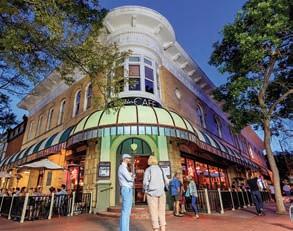

Keeping a firm grip on all the things that have made cruising a unique and memorable vacation experience, cruise lines have changed a few things to make the whole experience safer, more convenient, and—best of all—more fun for everyone. The same interesting ports of call await, but there are some new and innovative onboard activities and amenities that will make even the most experienced cruiser smile. by Alicia Atherton
Crisp air and a spectacular view enhance this cruiser’s Alaska experience.
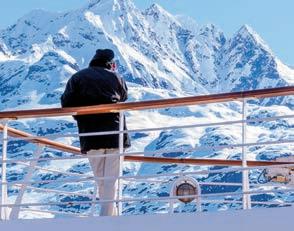
18 Holland—I Mean the Netherlands!
We commonly say “Holland” when we really mean the Netherlands. Although part of the Netherlands really is Holland—two provinces, North Holland and South Holland— only those two of the twelve provinces can truly claim that name. Whatever the names, a trip around the compact country is easy and rewarding. by Elsie K. Olsen
26 All Those Springfields!
Naming a new city or town Springfield was a very popular civic choice in the eighteenth and nineteenth centuries—and even into the twentieth century. There are so many Springfields that several popular TV shows have chosen Springfield as the generic town name for the show’s setting.We survey a selection of them. by M. Maxwell Richardson
Departments
14 Scenic Drives 16 Travel Bulletin 32 Travel Library
PHOTOS FROM TOP: DUSTIN HANDRICH / SHUTTERSTOCK; JAY L / SHUTTERSTOCK; KEVIN GEORGE / SHUTTERSTOCK; RANDY RUNTSCH / SHUTTERSTOCK The Old State Capitol served as the seat of Illinois government from 1839 to 1876. These traditional symbols of the Netherlands greet visitors on many a street.
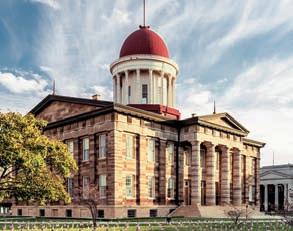
ODYSSEY Volume 53, Number 1, December 10, 2022. Copyright © 2022 . Cover or contents may not be reproduced in any form without written permission. ODYSSEY is a registered trademark. Chevron and Texaco logos are the registered trademarks of Chevron Corp. ODYSSEY (ISSN1073-5259) is published by the Chevron Auto Club. Address all editorial correspondence to ODYSSEY, 131 Stony Circle, Suite 500, Santa Rosa, CA 95401. • ODYSSEY and CA Bergquist & Associates, are not responsible for unsolicited manuscripts, photographs, or artwork. • ODYSSEY is produced for distribution to members of the Chevron Auto Club. Individual issues are not available. • Presorted Standard A Postage paid at Liberty, Missouri. (Permit No.1215) POSTMASTER: Send change of address orders to ODYSSEY c/o Chevron Auto Club, Post Office Box 830008, Miami, FL 33283-0008. ODYSSEY provides information about lodging rates, hours of operation, ticket prices and admission fees. Readers should be aware that these are revisedfrequently, and although believed to be accurate at press time, they are subject to change. It is the responsibility of the individual to verify details before travel.




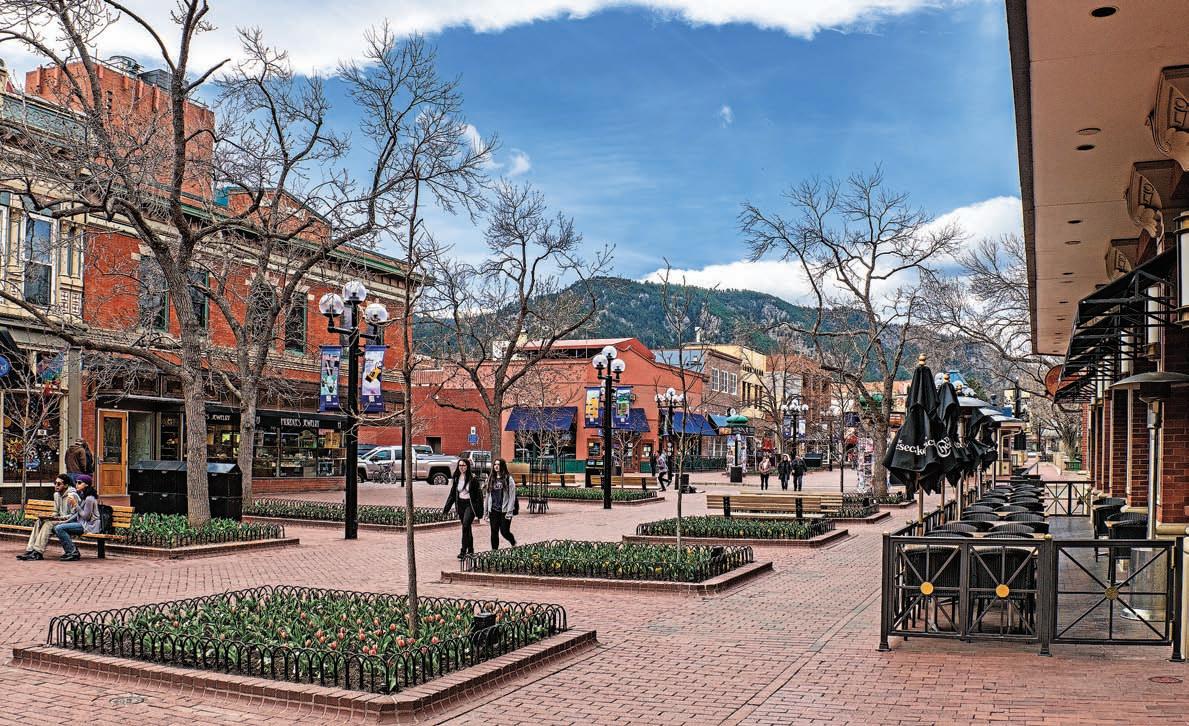
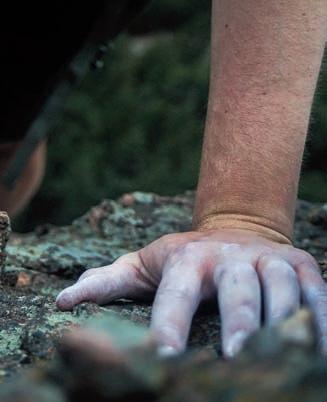
A ROCK SOLID COLORADO DESTINATION BOULDER
Chalk applied to hands (top) enhances the grip needed by rock climbers. Boulder’s Pearl Street pedestrian mall (above) presents Boulder in a most people friendly way. Hikers on the Chautauqua Trail (right) approach the iconic Flatiron formation. Fall color provides the backdrop for a view of Boulder Creek (opposite).
LITTLENY STOCK / SHUTTERSTOCK LITTLENY STOCK / SHUTTERSTOCK
By Allen Denson
It is said there are quite a few Texans in Boulder, Colorado. Maybe not so strange when you consider the reason. Much of Texas is decidedly hot and humid in the summer. Boulder is not. Simple as that. Well—not quite as simple as that. It actually has something to do with the turn-of-the-century Chautauqua Movement.
Back in 1897 both Boulder, Colorado, (est. 1871), and the Chautauqua Movement, (est. 1873), were fairly young. Both were entertaining visions of expansion. It so happens that in 1897 education administrators in Texas got the idea that teachers could benefit from 1) the intellectual-cultural Chautauqua experience, and 2) a summer stay at a somewhat cooler and less humid place. After an exploratory and ultimately persuasive visit to Boulder by the Texans, leading to the formation of the Texas-Colorado Chautauqua Association, a bond measure was passed by Boulderites to acquire land and fund the building of a brand new Chautauqua facility at Boulder. One hundred and twenty-five years later the Colorado Chautauqua is still going strong. And hosting more than a few Texans.
There are reasons aplenty (besides the Chautauqua) to make your way to Boulder, Colorado. Some folks go there to stay because it’s a nice place to live. But it is also a very nice place to visit— even if you are not simply taking a break from heat and humidity! Boulder is nestled against the base of a spectacular mountain range, and possesses the full array of shops, restaurants, lodgings, and activities one would expect to find in a smallish city of 108,000. The plus factors here are the cultural, sporting, and entertainment events at the university and the truly wide range of outdoor activities afforded by the location. Of Boulder’s population, over one third is associated with the University of Colorado, including 37,000 students. So you might find yourself or someone you know heading to Boulder for a college education. Or—for higher education of a different sort—some serious tutelage in the culinary arts. In 1991, what would become the Culinary School of the Rockies was formed in Boulder. With success came a name change and a tie-in with the prestigious Auguste Escoffier Foundation, the living legacy of the esteemed French chef Auguste Escoffier (1846-1935), father of the kitchen brigade system, the à la carte menu, and a number of recipes developed during his culinary oversight of some of Europe’s most prestigious restaurants. Boulder’s Auguste Escoffier School of Culinary Arts, now with a sister campus in Austin, Texas, provides a variety of programs ranging from professional chef training to home cooking instruction. The focus is on the popular farm-to-table movement, enhanced by student extern time at a local farm-producer.
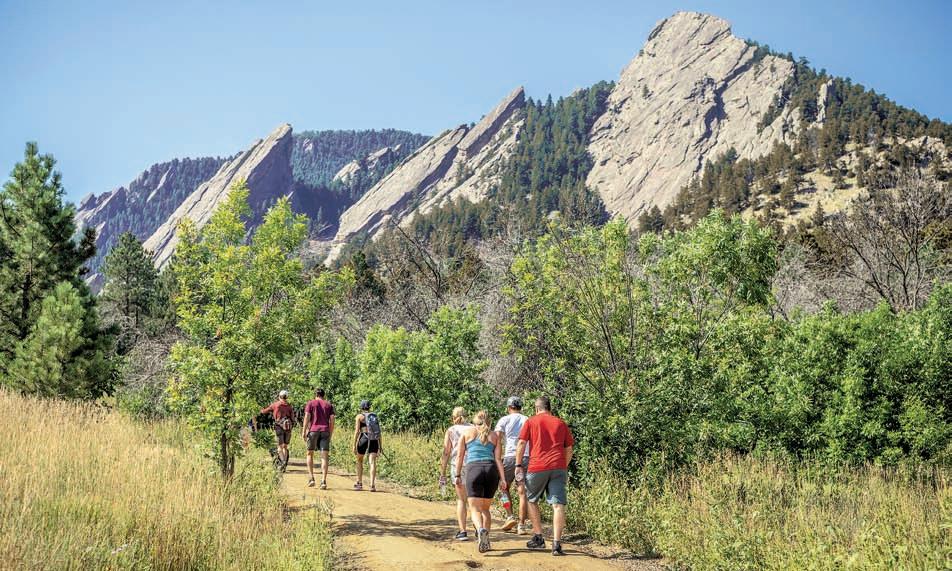
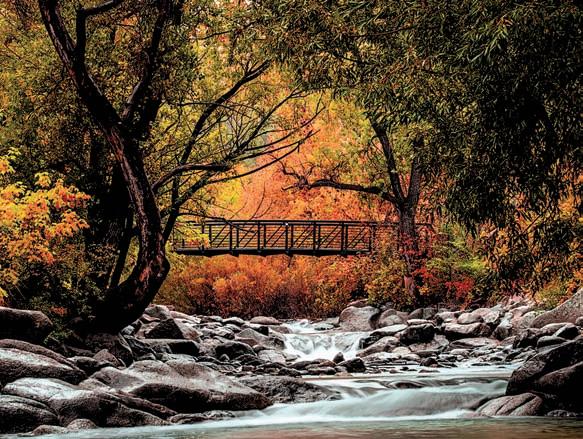

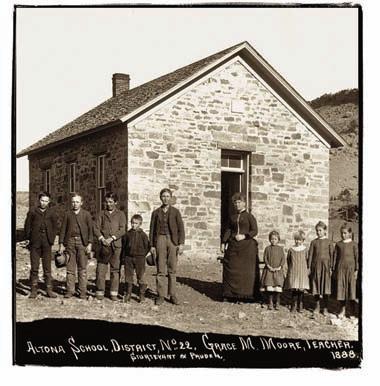
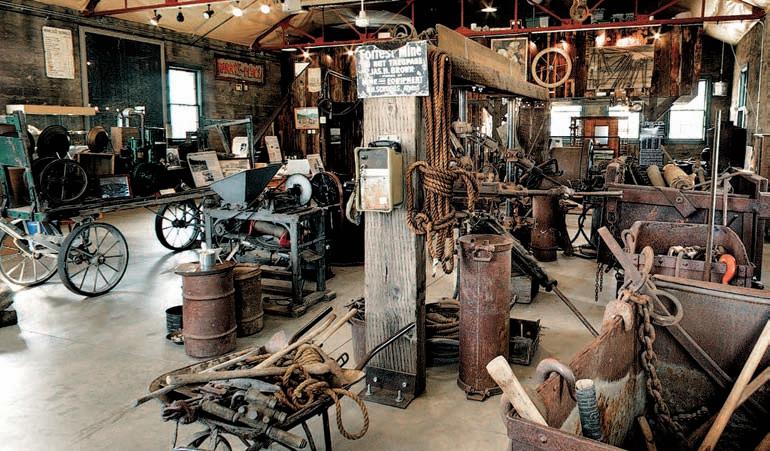
Assembled over a threeyear period by artisans from Tajikistan, the Dushanbe Teahouse (above) was gifted to Boulder in 1990 by its ancient Silk Road sister city Dushanbe, Tajikistan. The mining museum (below) at Nederland, west of Boulder, makes a good day-trip destination. Old Main (right), once the whole of the University of Colorado, is now a valued component of its history.
Back to the Chautauqua movement—Founded on the shores of Lake Erie in Ohio, the original institution quickly moved to western New York, where the seminal facility, now a National Historic Landmark, still operates. As a movement promoting education based on the principles of the original, many traveling Chautauquas covered the states during the late nineteenth and early twentieth centuries. A few permanent facilities took root operating on a year-round schedule, the one in Boulder being one of the earliest. Offering guests a smorgasbord of lectures, performances, and recreational choices plus on-site accommodations if desired, the Colorado Chautauqua, now with its own National Register of Historic Places designation, is a special facet of the Boulder experience.
Running through town is Boulder Creek, named for the boulders that had tumbled down from above. It shared its moniker with the settlement that arose on its banks and thus Boulder City was born (except that it was known as Red Rocks for a brief time). This happened in the late 1850s when prospectors combed the area for gold deposits. In 1859, Boulder City was established by a group of prospectors in what was then the Nebraska Territory. Having incorporated, the shareholders in the Boulder City Town Company sold plots of land along the creek and eventually the town developed. Two years later, in 1861, the Colorado Territory was established and Boulder City eventually became the county seat of Boulder County. The town’s growth at this time was attributable in the main to the prospectors who arrived in town, got their bearings, then fanned out into the area’s canyons and valleys to seek their fortunes. Boulder’s economy centered around supplying the region’s miners with the goods and services they needed.
Gold prospecting quickly moved farther and farther out, into the mountains, away from Boulder. This led to the creation of the smaller, more remote mining towns that still dot the mountainous slopes and valleys above Boulder. Some are small working towns to this day, others are ghost towns, but whatever their current state, they make interesting side trips from Boulder.
Information on these towns has been collected, along with available historical photographs, by the organization Western Mining History. It should be noted that although it was gold—discovered in 1857 by W.G. Russell and a group that included Cherokee Native Americans—that caused the Pikes Peak Gold Rush and spawned Colorado’s mining boom, other metals, notably silver and tungsten, were also mined and processed in the Front Range. Mining, in fact, was the major component of Colorado’s economy well into the twentieth century.
As the U.S. population expanded westward in the 1800s, the need for education accompanied the push. Towns like Denver were growing into cities, and on a flat, barren plain at Boulder, the building now known as Old Main rose up. It is today the centerpiece of the thoroughly modern University of
Colorado. Alumnus Scott Carpenter was the second human to orbit Earth, and among the faculty are five Nobel laureates in the fields of chemistry and physics. But for us visitors there is the Colorado Shakespeare Festival that for over 60 years has brought the bard’s work to life in a summer outdoor setting on the campus at the Mary Rippon Theatre. A full calendar of music and theater events at the university keeps students, locals, and visitors entertained any time of year. The beautiful Macky Hall is a world-class auditorium, and along with several other stages, hosts performances by visiting jazz, classical, opera, and dance performers. The superb UNIVERSITY OF COLORADO HERITAGE CENTER facilities are home to the Takács Quartet and the university’s symphony orchestra. If you are a CU alum you certainly know about Buffalo sports. Attending a game is a great excuse to make a trip back to Boulder. And if you follow a team scheduled to play the Buffaloes—in Boulder—that’s a good reason for a visit, too. While in town, take advantage of Boulder’s longtime commitment to its parks and open spaces. In fact, you could make that your main reason for your visit! The city and the county together maintain an extensive array of parks, museums, historical sites, some 300 miles of trails, and open land. There are so many facets to Boulder’s recreation scene, we’re able to note just a few. Not surprisingly the sport of “bouldering” is popular. Climbers, from expert to novice, are afforded many spots in and around Boulder to practice their sport. For the somewhat less agile among us there are numerous trails to be hiked or biked, replete with fresh mountain air and grand scenery. The Boulder area is the training ground for a number of professional cyclists, but the same roads are open to general cyclists, including bike friendly lanes all around town. Electric bikes are now a popular cycling alternative, but are restricted from a few of the local routes. If fly fishing is your thing, you will want to check out Rocky Mountain Anglers, a store and much more. RMA offers a large selection of tackle, along with clothing, classes, and a selection of guided trips. And their website posts local river reports. Among Boulder’s sixty public park offerings is Eben G. Fine Park on Boulder Creek near the city’s founding spot. The park is a popular place to see rock-balancing art. Boulder-based
CHRIS KELLER / GOOGLE MAPS / EARTH / BOULDER COUNTY Michael Grab, a phenomenal practitioner, travels the world demonstrating the delicate art of balancing rocks, having honed his skill with the stones in Boulder Creek. You are welcome to try your hand!
Boulder County has set aside over 100,000 acres of natural open land—laced with trails (from easy to challenging) and dotted with historical sites. One such site is the old stone Altona Schoolhouse, north of town at the southern end of the Heil Valley Ranch network of trails. Visitors take a step back in time as they enter the restored and furnished
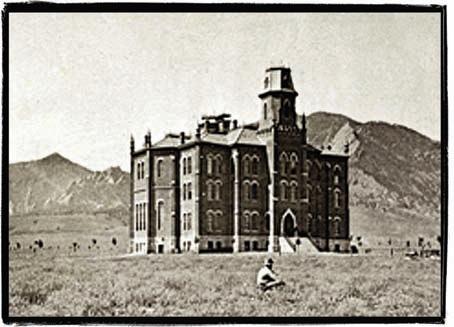
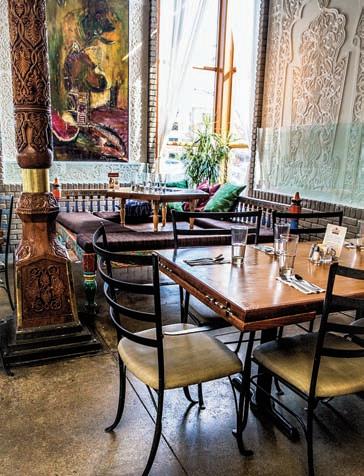
c. 1880 schoolhouse. There is much you can do on your own, of course, but guided tours also are offered by a number of providers. A selection includes cycling excursions (road, mountain, or e-bike), horseback riding, beverage sampling, snowshoeing, rafting, rock climbing, fly fishing, star gazing, hiking (of course!), and even hot air ballooning—almost anything you can think of.
As a tourist, getting out of Boulder proper on four wheels (or on two if you’re so “inclined”) means heading for the hills—or rather the mountains. The roads themselves heading west into the Front Range are worth the excursion alone. They are smooth, curvy, passing alternately through meadows and wooded sections, past rocky cut banks, and punctuated with places to stop along the way such as little trailhead parking lots. The main route into the mountains is Boulder Canyon Drive, which, among the several drives out of
No glue or cement, only gravity, holds these rocks (below) in balance in Boulder Creek. The Altona Schoolhouse, (bottom) as it appeared in 1888, now restored, presents visitors with a view back to that time in Boulder’s history.
MICHAEL GRAB/GRAVITY GLLUE
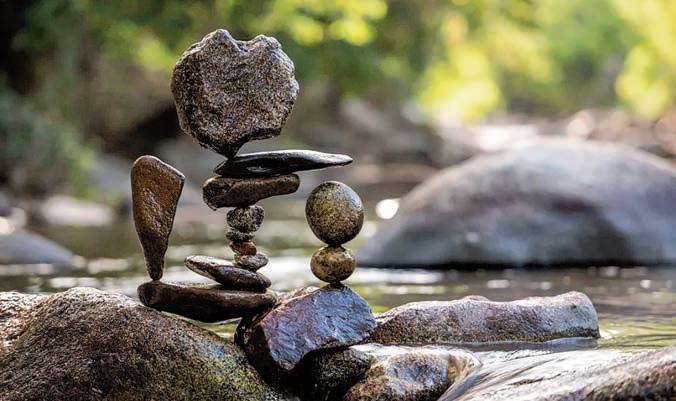
CARNEGIE LIBRARY FOR LOCAL HISTORY / MUSEUM OF BOULDER COLLECTION




HOSPITAL INDEMNITY
ACCIDENT BENEFIT PLAN*
Coverage For Hospital Confinement Due to a Covered Accident
Give your family added coverage with this optional insurance plan, at an additional cost. Provided for Chevron Auto Club Members.
Benefit Highlights
• Benefits are paid directly to you – regardless of any other insurance you may have. • No health questions asked or medical examinations required. • Coverage is available to you and your eligible dependents, as a Chevron Auto
Club Member in good standing.
FOR DETAILS CALL 1-800-222-0585
This policy provides limited accident-only benefits. This policy has exclusions, limitations, and terms under which the policy may be continued in force or discontinued. See the plan description for more complete details of coverage. Chevron Auto Club Hospital Indemnity — Accident Benefit Plan is underwritten by Life Insurance Company of North America.





Fall color brightens this spin down the Peak to Peak Scenic Byway that traverses the ridges and valleys of the Front Range to the west of Boulder.
Boulder, will get you up to the top most expeditiously. And at the top you will find Nederland, a historic mining town that sits astride Route 72, the Peak to Peak Scenic Byway. The first of Colorado’s official scenic byways, the 100-year-old Peak to Peak snakes its way for 55 miles from Estes Park in the north to I-70 at Idaho Springs in the south.
Nederland is one of the old mining towns west of Boulder that make for a good day trip. Its comprehensive mining museum presents the town’s mining history along with a steam shovel, one of the many used to dig the Panama Canal, and later used for mining near Nederland. Just a couple of miles to the west of Nederland is Eldora, Boulder’s closest winter ski facility.
Twelve miles north of Nederland on the Peak to Peak Scenic Byway is Ward, another once prosperous town with a mining history. There are a few historical relics around Ward, but from Ward a trip down to Gold Hill takes you to the very rustic and period-authentic town in which preservation has been a priority since the early 1900s— thanks to the Bluebirds of Gold Hill, a women’s group from Chicago that convened regularly at Gold Hill, building their lodge there in 1920.
Between Ward and Gold Hill runs the gravel-paved Lickskillet Road, claimed to be the steepest county road in the country. If you want to drive the steepest and the highest (paved) road in the country in the same day, drive south on the Peak to Peak byway through Black Hawk, a funfilled casino town with many preserved mining-era buildings along old Main Street in the historic district. Pick up State Hwy 103 south of Black Hawk at Idaho Springs for your trip to—or rather up—the 14,150foot high Mt. Evans. And yes, there thankfully is ample space to turn around at the top. You will take the same road back down.
One last mining town to mention, though not a town at all (anymore), is Wall Street. It’s closer to Boulder and accessible by car or bicycle via Fourmile Canyon Dr. directly from town. The Colorado Wall Street was indeed named for the one in New York City, as a way to convey the financial aspirations and mining potential of the town and its developer, one Charles Caryl. An elaborate extraction mill employing revolutionary technology was built, the foundation of which is still present at Wall Street. The mill project failed, and all that remains in the former town are the great stone foundation, and an assay office that is now a mining museum.
Coming down from the mountains of the Front Range, we are tempted to say we have merely hit the high points of a trip to Boulder and its surrounding area. In many ways that is true. Boulder is a town of many possibilities— educational, cultural, and certainly recreational!
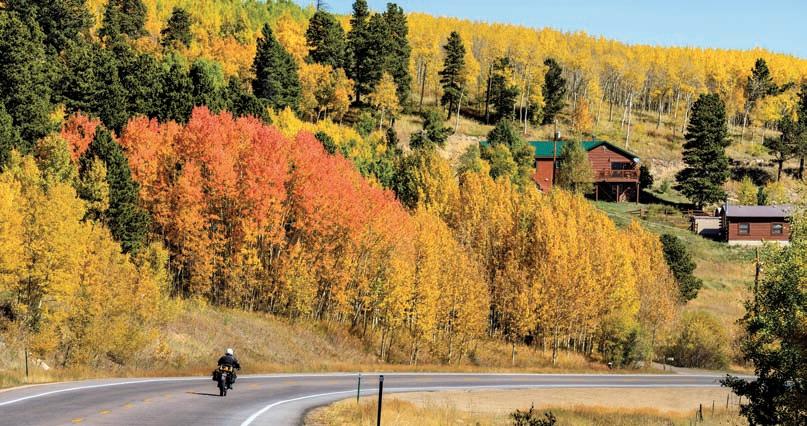
SEAN XU / SHUTTERSTOCK BRANDON IWAMOTO / SHUTTERSTOCK
The highest paved road in the United States (left) snakes its way to the top of 14,150-foot Mt. Evans.The area’s mining days are preserved in the buildings of Central City at Black Hawk (below left). The foundation is all that remains of the large operation at Wall Street (below).
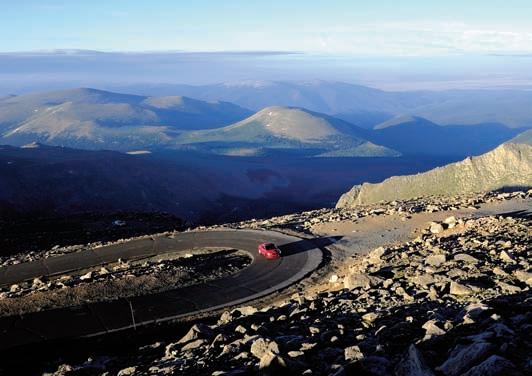
WESTERN MINING HISTORY
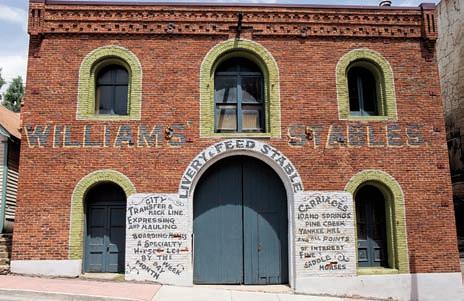
REX JAYMES / SHUTTERSTOCK
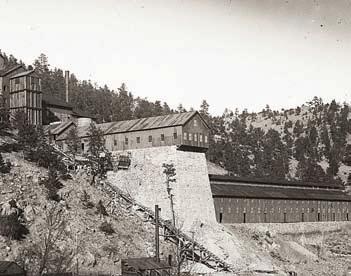
I NFORMATION FOR T RAVELERS
Boulder’s city webpage found at https://www.bouldercoloradousa.com/ is one-stop shopping for everything you might want to see and do around town—including places to eat and places to stay. Included are special guides, viewable online or in print by request, covering everything from the extensive local area shuttle service to a farm trails route.
A special section included in the Boulder website covers guided tours provided by local operators. Find it at https://www.bouldercoloradousa.com/thingsto-do/experiences-and-tours/outdoor/.
A bike trail map for Boulder and Boulder County can be viewed at: https://assets.bouldercounty.gov/wp-content/uploads/2022/08/boulder-countybike-map.pdf. The map is also a very good one for navigating, by car or motorcycle, the small roads, paved and gravel, that lead from Boulder west to the mining towns and ultimately to the Peak to Peak Scenic Byway.
The Boulder County website features a tab, https://bouldercounty.gov/departments/parks-and-open-space/, that emphasizes outdoor recreation. It features parks and other destinations that specialize in activities such as hiking, fishing, and rock climbing to name a few.
Boulder is home to Michael Grab, preeminent rock balancing artist. His work is featured in this website, https://www.anart4life.com/the-peacefulart-of-rock-balancing/ with text, photographs, and videos. Michael’s own website, www.gravityglue.com is a look at his extensive body of work.
Fly fishers will want to check out Rocky Mountain Angles in Boulder. The website is https://www.rockymtanglers.com/. The store is located at 1904 Arapahoe Avenue in Boulder.


CRUISING YOUR HOME SHORES
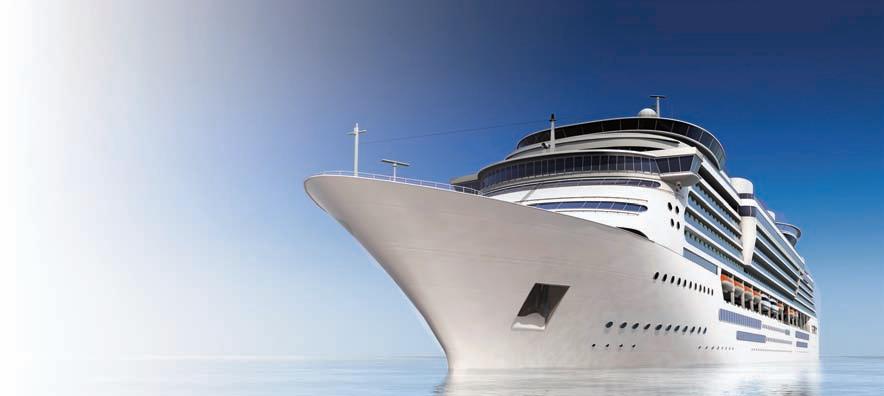


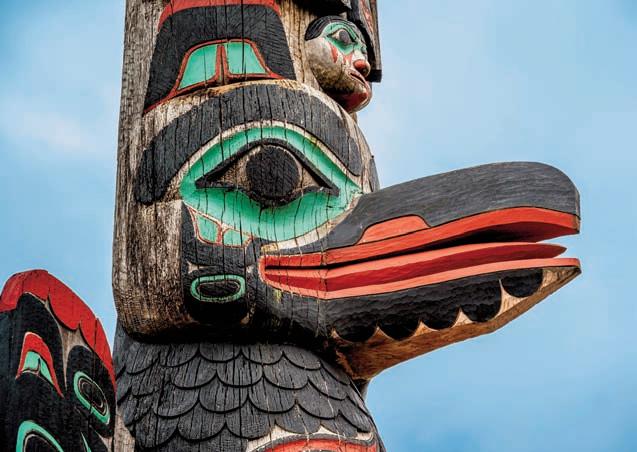
Stylistic animal depictions (above) are an integral part of totem pole carvings by indigenous Tlingit, Haida, and Tsimshian tribes. Poles were carved as memorials to the deceased, as storytelling venues for the community, or for clans to memorialize the family’s ancestry.

THE EAST AND WEST COASTS OF NORTH AMERICA
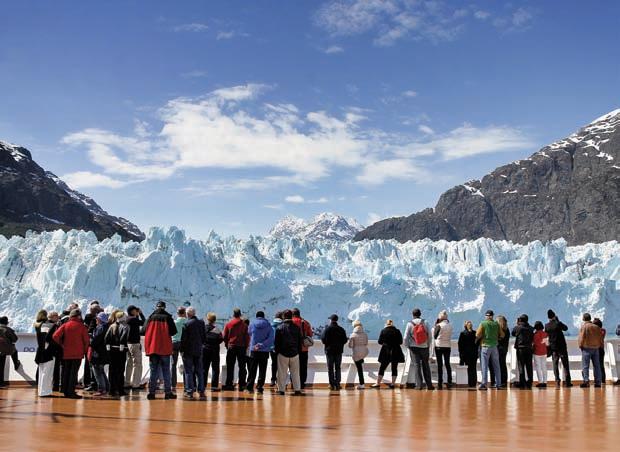
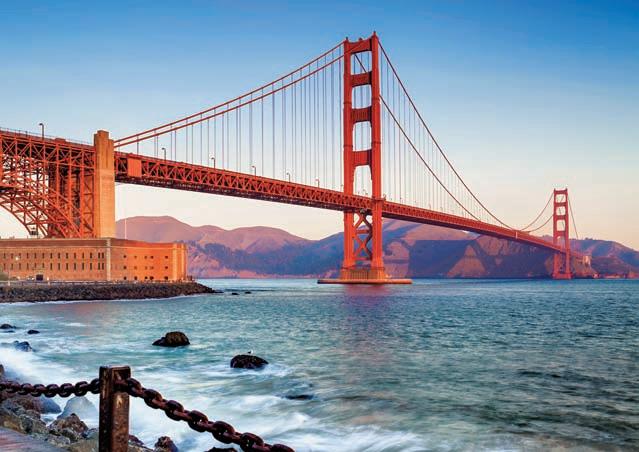
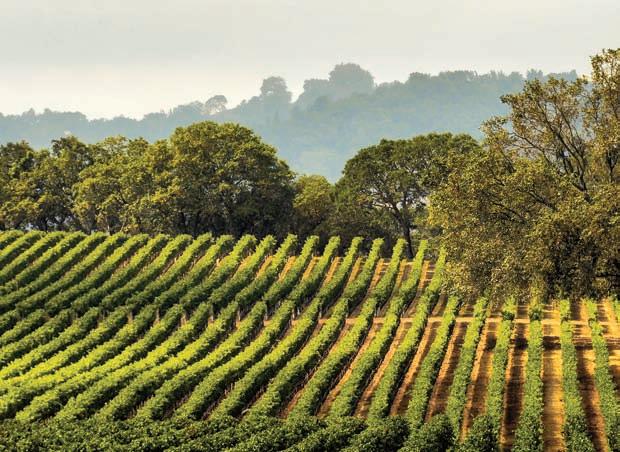
CPHOTOS: LEFT: JEFF WHYTE / SHUTTERSTOCK; ABOVE::YUESTOCK / SHUTTERSTOCK ruising is back and the new ships are bigger, and frothier, than ever with new tech, new activities, and new amenities of every stripe. Whether you’re traveling with the family, with friends, as a couple, or even solo, the cruise industry continues to add choices to better fit your wishes, and your budget.
You really don’t have to leave the U.S. to enjoy a fantastic cruise. Both coasts of the U.S. have updated harbors to accommodate the new, and nearly new, mega-ships, as well as smaller expedition ships. There are over 13 boarding/ disembarking ports spread out along the two coasts, with many thoughtful amenities and conveniences built into the harbor areas to make the start and finish of your vacation smooth sailing.
Over the years, and with lots of lessons learned during the pre- and postpandemic years, they have added increased safety and convenience protocols such as advanced air filtration systems, new sanitizing and disinfecting technology, touch-less electronics, streamlined muster station drills, buffet items served by wait staff, expanded medical services, increased wi-fi, and daily information, including your itinerary, delivered via an app on your phone, to name a few. For those who have been on cruises previously, using an app on your phone to make reservations for dining and shore excursions is a big plus. Some apps
PHOTOS: ABOVE: GARY SAXE / SHUTTERSTOCK; TOP RIGHT:JAMES STEIDL / SHUTTERSTOCK; MIDDLE RIGHT: RUDY BALASKO / SHUTTERSTOCK; BOTTOM RIGHT: SOLARISYS / SHUTTERSTOCK
even allow passengers to use their phone as a room key—beating the “I dropped my key somewhere” nightmare.
Whether you hop aboard on the East Coast or West Coast, there are convenient ports within a day’s driving of the majority of travelers (clearly not everyone). Boarding in San Francisco or Seattle on the West Coast, you can choose north or south sailings. Go north and head to the perennial favorite, the “inside passage” of Alaska, or head south to follow the Pacific Coast Highway and enjoy whale watching, wine tasting, and the iconic beach towns of southern California.
On the East Coast, start at our own history-rich cities of New York or Boston, and head north with possible stops at Providence, Portland, Bar Harbor, or Martha’s Vineyard, before hitting Canadian harbors. Or, pick a cruise that heads south to places such as Norfolk, Charleston, Port Canaveral, Ft. Lauderdale, Miami, Bermuda, and islands privately operated by the cruise line. There are even a few cruises that start in Miami and go all the way to Quebec with several stops at U.S. cities. All of this right at, or close to, our own shores!
In response to queries about cruising, we’ve often replied that cruising is not so much about traveling, but more about vacationing—you can be as
Cruise ships (top) come in all sizes and you can choose which cruise will suit your needs. The vineyards of Sonoma and Napa (above left) in Northern California produce world-class wines. Walking across the Golden Gate Bridge (above right) is a popular shore excursion activity for San Francisco’s port of call.The generous breakfast (above) comes with a view.

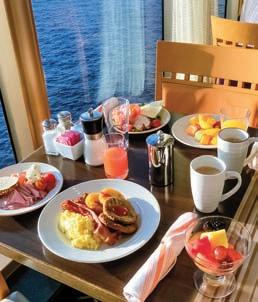
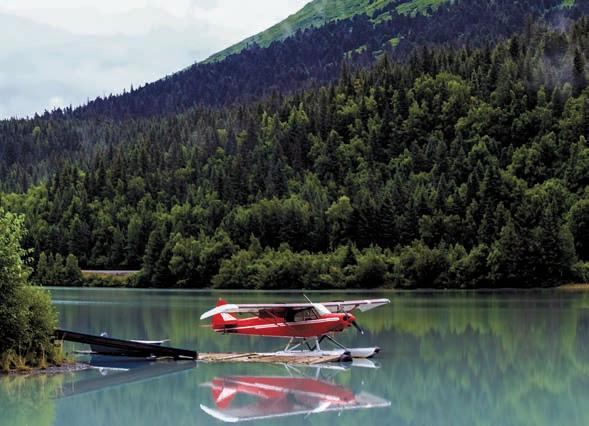
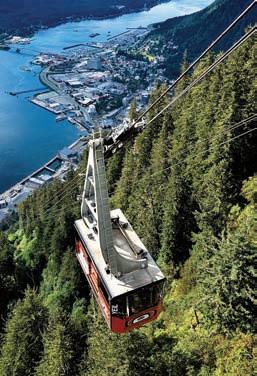
DARKO MARKOVIC DARKO / SHUTTERSTOCK
Famous artist, Nathan Jackson (top), of Chilkoot Tlingit heritage, demonstrates his technique in front of visitors to the Carving Shed in the Native Village in Saxman, near Ketchikan, Alaska. The tramway in Juneau (above) climbs up Mount Roberts for stunning views, and at the top, a nature center, shops, a theater, restaurant, and hiking trails await visitors.
Seaplane flights are a popular excursion. Here a plane (right) has landed on a placid lake high in Misty Fjords, where the pilot waits for passengers to return.
relaxed and pampered as you want while enjoying the gentle (most of the time) motion of the ocean. However, if you want to “travel,” the pre- and post-excursions and numerous shore excursions at ports of call certainly fill that bucket list.
There are also cruise line offerings, fairly new to our shores, on smaller ships, that emphasize expedition-style cruising (premium pricing) where the onboard expedition crew will help you get up close and personal with nature, while not roughing it. There are far fewer passengers on these vessels and the passenger-to-staff ratio is often 2-to-1. These vessels are also capable of visiting much smaller harbors, allowing them to travel further inland via smaller waterways.
Getting to the heart of it, sussing out which cruises offer which shore excursions at each port of call is well worth the effort before booking. But, keep in mind, things happen (like hurricanes) and occasionally a port of call must be dropped due to circumstances beyond the cruise line’s control, so be prepared if you’ve set your sights on just one place that is a must-see for you. This is where travel insurance can rescue you if something unforeseen happens—whether it’s a medical reason, cancelled flight, weather, or multiple other situations— depending on which insurance package you purchase. AMANDA WAYNE/SHUTTERSTOCK Currently, there are insurance packages that will even cover cancelled shore excursion costs plus related expenses.
Caribbean sailing routes, from the East Coast, typically commanded the newest ships, but the West Coast routes, with the ever increasing popularity of Alaska and Latin American ports, are beginning to see brand new ships deployed. Princess Cruises, one of the first on the West Coast, has over 50 years of sailings out of San Francisco’s port—there are now more than 15 cruise lines using the port—and Princess just added a new ship in 2022, with more to come. If the newest and shiniest ship is what you are after, all the cruise lines eagerly brag about their new ships coming out, so they are not hard to find. Remember, though, that older cruise ships, just like hotels, are regularly refurbished, and new amenities and programs are added or dropped according to passenger preferences. The date of refurbishing is listed on almost all the booking websites, so you will know exactly when the ship was last touched up.
You can plan your cruise to coincide with fall foliage, springtime blooms, or maybe just to get away from the summer heat. No matter which season you choose, there are plenty of shore excursions that take advantage of what nature has to offer. There are shorty cruises of 3 or 4 days, which are fine, but if you’re in need of some true R&R, I would recommend at least seven days. And, if you have the time, a round trip of 13 to 15 days really gives you the time to take advantage of all that cruising has to offer.
Combining historic city tours with the colorful fall foliage season is one of the most popular ways to cruise the East Coast. Though the timing of the changing of the leaves is not precise, you’ll never be left high and dry as there is so much natural beauty to photograph from the ship, or to explore on shore excursions, with or without the spectacular fall colors. Out West, aside from Alaska’s famous inside passage, the cities of San Francisco, Los Angeles, and San Diego are the most requested bookings.Your primary window of opportunity on both north coasts is generally mid-May through September, while the south coasts have an expanded time frame.

ALASKA
Our very first cruise was to Alaska and it was fabulous, so it will always remain a favorite destination for us. Our tour was round-trip out ofVancouver, B.C., but there are several options. Round-trip does save a little money, as driving or flying in and out of a single location is generally less expensive. The tradeoff is that usually, not always, there are fewer stops and less time in port to enjoy the excursions, and more time at sea. One-way trips generally allow more time in port and have more excursions, which include both pre- and post-excursions at different locations. But, honestly, no matter if you chose one-way or round-trip, your Alaskan voyage will be memorable.
A classic cruise to Alaska will be seven nights round trip and will board in Seattle or Vancouver, but San Francisco has recently been added for a few sailings. All great locations for pre- or post-cruise excursions.
The “Inside Passage” of Alaska is a truly unique voyage, as the waters of the channels are unusually deep and wide compared to other locales so that large ships can navigate up close to sheer cliffs and glaciers.
All the towns on the port stops offer a wide variety of free self-guided walking and hiking tours, as well as guided tours, with plenty of local history highlighted. Shore excursions available for purchase include hiking tours with knowledgeable guides, fishing charters, dog sledding, helicopter rides to an ice field, and Zodiac adventures, to name a few. Two of the most memorable for us were the seaplane trip, out of Ketchikan, which circled and landed on a pristine lake high up in the peaks of Misty Fjords, and a guided hike inland at Skagway along a trail
that included 4-foot-tall skunk plants that bears eat at certain times of the year—we saw bite marks and paw prints. Each town’s history means that each port has a different focus, whether it be man-made history or nature-made awesomeness.
DANCESTROKES / SHUTTERSTOCK
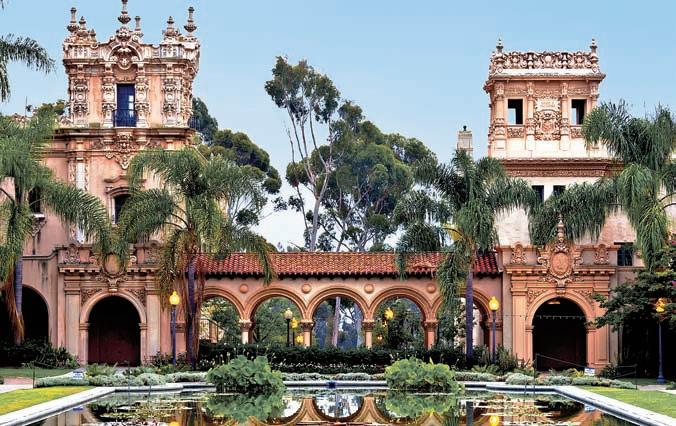
WEST COAST
The hustle and bustle of San Francisco, with its clanging cable car bells, the lively Pike Place Market in Seattle, and the glitz of Hollywood offer favorite cityscape excursions that punctuate the cruises along the West Coast that typically have a relaxed, laid-back vibe that matches the weather and the scenery.
Visits to wine country (Sonoma and Napa in the north, and Santa Barbara in the south) have become favorites on the excursion list. Some cruise lines are upping the experience by offering onboard wine tastings, food pairings, and education to highlight California-style wine and cuisine— by the time you arrive at the winery, you won’t feel like a novice.
Santa Barbara, often called “America’s
DAILY TRAVEL PHOTOS / SHUTTERSTOCK
When cruising the West Coast, Balboa Park (top) is a not-to-be-missed excursion for the San Diego port of call. The iconic cable cars of San Francisco (above) ply the hills of downtown as they have for many decades.
